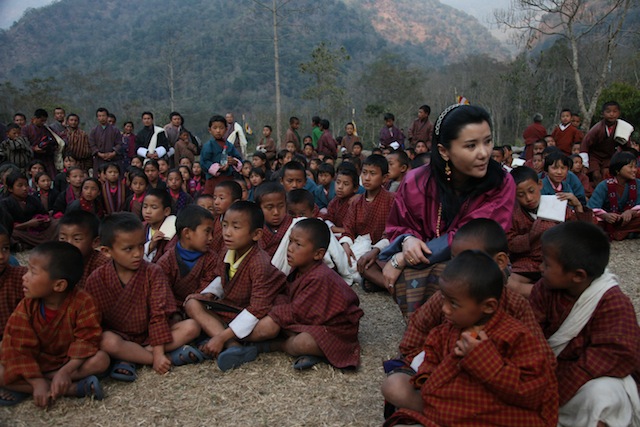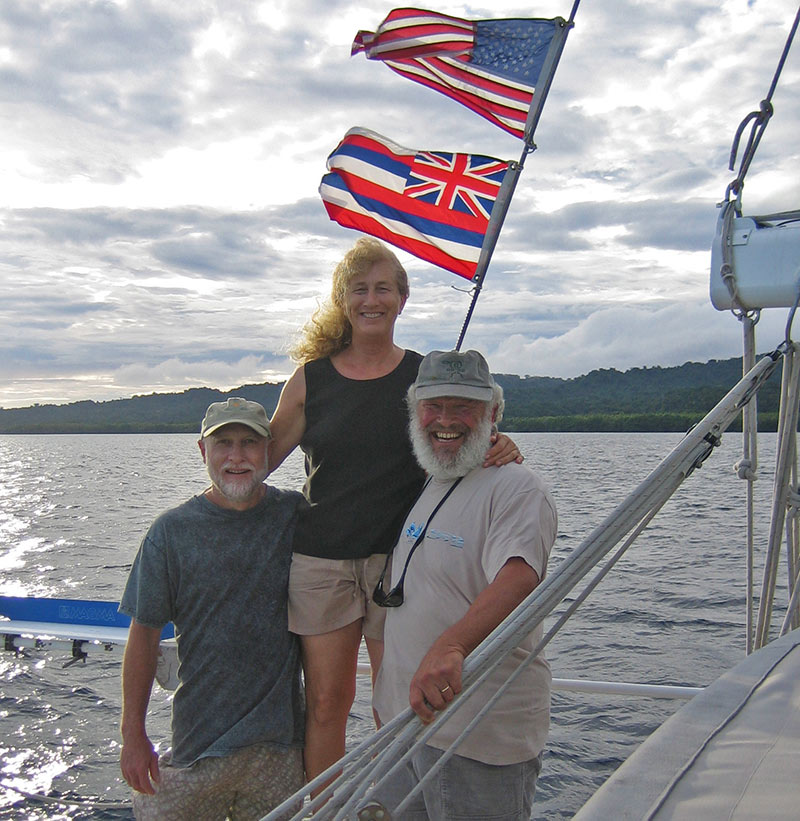While travelling with Queen Ashi Sangay Choden Wangchuk of Bhutan, we also wrote a blog post for NPR’s The Hidden World of Girls
Journalist and radio producer, Stephanie Guyer-Stevens, recently returned from Bhutan where she and her co-producer Jack Chance were covering the trek of Queen Ashi Sangay Choden Wangchuk. As she wrote in a note to us before her journey,
“The Queen is going trekking in the remote Sandrup Jonkhar district in southeastern Bhutan. Her focus on the trek is to go and meet the people who don’t have access to her – most people in Bhutan live more than an hour’s walk form a motorable road. So she treks out to meet people, mostly to talk about domestic violence, which is a big problem in Bhutan, and generally to talk about different social issues. She’s invited me to come and document the journey. So I said, yes.”
Stephanie has a radio piece about her trek with the queen on Radio Netherlands and another airing soon on NPR’s Hearing Voices (take a sneak preview here on PRX.org)
Here are a few dispatches Stephanie sent us along the path:
Feb 22, PARO:
Right now it’s 7:55pm on Wednesday in Bhutan, (which is in the same time zone as Bangladesh, if you’re looking at time zones), and it’s 5:55 am in Los Angeles on Wednesday. So it’s a fourteen hours difference.
It’s been really lovely to be here in Paro for the first two days of my time here. It’s hard to imagine that this is the second largest town in this country. I’m kind of partial to this place over Thimpu. This morning I woke up just after sunrise and looked out my window at the road below. Although the snow on mountaintops above the valley were pink with the light from the sun which was still climbing up behind them, the road below the hotel here was still swirled in early morning mist, and slowly I could make out the figures of a few people walking along the otherwise empty road, accompanying their ponies. I’ve been in my room almost all day, actually, trying to get myself ready for this trip. It’s been a big opportunity for me to think about alot of things – about myself in relation to my creativity perhaps the most. What can we do to make a beautiful thing? Where are we going to go with this? We have alot more to figure out still but I know we won’t be able to avoid the inevitable, which is that so much we won’t even know until we begin the work itself, no matter how much I try to anticipate.
Feb 25, THIMPU:
The Frantic Meter at RENEW is at an all time high – they are managing the logistics for the twelve person entourage for the entire trip. Rounding up enough chairs and a p.a. system in these remote villages, booking solid the only hotel in town, making sure the ponies all have saddles.
I have been keeping our own pace pretty slow – yesterday met up for tea with Françoise Pommaret, who in turn introduced me to Kunzang Choden, the prolific Bhutanese author – she’s wonderful, and we’ll be recording her tomorrow telling folk stories which I hope will provide a beautiful dimension to the doc.
I don’t quite feel ready for departure, but I’m very very excited to leave.
March 1, SHINKA LOWRI:
I’m standing on the edge of a hill looking down at an open flat field, filled with hundreds of Bhutanese schoolchildren and villagers, sitting on the ground in perfectly straight rows, listening to a speecha about std’s, AIDS and reproductive health issues, while the Queen of Bhutan sits and looks out at them. I look around me – the hills rise up from this river canyon on all sides.

It’s hot, at least compared to Thimpu – hot enough that my kira is pretty uncomfortable after hours of walking in the sun, which is what we did to get to this place, called Shinka Lowri. Three hours is the shortest walk to any road from Shinka Lowri, although the people who are here tell me none of them actually live here. They all live at least three hours’ walk beyond here in the hills around this place – this is just where they all come to get together.
March 6, PEMAGATSEL:
It’s morning. We’re on the top of a hill above Sandrup Jonkhar, outside the Officer’s Mess, where we’ve been hosted since yesterday afternoon. Its sunny, but the sky is hazy. Everyone here claims the haze is from India. People in Bhutan seem to generally concur that all things bad come from India – pollution, plastic, bad habits.
But up on this hill it’s peaceful. The buildings of this complex were probably built in the 1970′s – concrete and stone, the walls painted a pale yellow – very pretty in the early morning sun, beautiful with purple bougainvillea. We’ve finished our breakfast – today it was fried rice with fried eggs, and the usual salad of chilies, cabbage, and yak cheese, a combination I’ve come to really enjoy – accompanied by suja and what they call sugar tea. I’m not sure if there is any actual tea in the sugar tea, or if its just milk water and sugar.

Nevertheless, we’re all anxious to leave, delayed by a roadblock, a common occurrence in Bhutan. It’s either winter and the snow is pushing boulders along, or it’s summer and monsoons are causing landslides. So all year round roadblocks are a big part of traveling by car in Bhutan. In general travel in Bhutan is slow. As Yeshe pointed out, it takes longer to travel from Tashigang to Thimpu than to fly from Thimpu to the United States. It takes two full days of driving to get to Tashigang from Thimpu, and 30 hours or so to fly to the U.S.
I’m still sleepy, even though I had a pretty full night’s sleep. Maybe it’s my body still expecting coffee in the morning, or maybe I’m still recovering from the 10 hour hike out of Shinka Louri.
Today we will drive as far as Wamrong, where we’ll be having lunch and then spending the night at Chimi’s father’s monastery.
March 6, ROAD BLOCK, THE TRUCKS OF BHUTAN, WAMRONG MONASTERY
We drove an hour from the military camp towards Wamrong, where Chimi’s father lives, and are now parked on the road behind a landslide. The landslide is slowly being cleared with the use of Project Dantak, the border road maintenance group, run by the Indian government. The bulldozer driver had no hard hat. Just him and massive boulders over his right shoulder, and a sheer drop to his left.
Nevertheless this is apparently daily life for Bhutan. Everyone is interested in the progress of clearing the slide, and everyone is calm, sitting in their cars playing cards, dozing off, eating lunch.
Finally after returning to the military camp we got word that the roadblock was cleared, so Chimi, Sonam the driver, Jacob and I headed back out to the road, just before sunset. Miles and miles of dust and rocks, the stretch of the road where the work is being done to widen it, and as we approached dark, and approached the site of the landslide the trucks which had waited on he other side of the slide for two days began their descent towards us – probably over a hundred in total – flashing winking colored lights around their windows, blinking their headlights at us to let us know they were coming towards us.
The amazing painted trucks. All the trucks have eyes – beautiful almond shaped eyes with long, long lashes – painted above their headlights. The back says Blow Horn, the sides have the letters writing the name of the company painted in as beautiful design as possible, and the metal work is done in the shape of sacred designs. Somewhere on the side panels is a painting that is the signature of the artist.

Now that it’s night, one truck turns off one of its headlights and instead a purple then blue then green light glows in that one eye instead. The trucks and their drivers are a world apart – wild – driving through Bhutan, Nepal and India in these untamed one lane mountain roads. Eventually the line of trucks diminished, the dirt and rocks gave way to a one lane paved road that continued to wind for miles through the dark mountains, a sliver of a moon hovering in the sky, a few stars scattered through the tops of the trees. We finally passed through village of Wangdru, now almost at the turn for the monastery where Chimi’s father lives. In the dark it looks like a medieval town – old earth houses fronted by stores, painted white with brown doorframes, the doors flung open, a single bulb burning in each store, exposing in one a pile of potatoes, a pile of onions, yak cheese hung by a string from the roof. Outside along the dark street people walk from house to house – dogs surround them.
We make the turn up the winding dirt road through the dark trees which brings us finally to the bottom of stone stairs, which we can see in the lamplight lead up to an old traditional two story house. Standing out of the lamplight, I see an old monk who I know must be Chimi’s father waiting to greet us. As we get out of the car he comes down the steps to meet us, kindly accepts the white scarf which I clumsily hand to him, and we follow him and Chimi up to the house.
Inside the walls are faded paintings of scenes of wild animals, holy men and the whole array of sacred designs. Hung along the walls and ceiling are various religious banners, and behind the curtain of the front room is the living room, filled with two old stuffed couches, some chairs, some traditional wood-carved tables with carved and brightly painted dragons and tigers around their base and fake wood panelling on top. Around the walls are photos of Chimi’s dad and brothers with the fourth and fifth kings, one of Chimi and Ashi, and various other family photos. Two women serve Jacob and I traditional dinner, with whire rice served in two covered wooden calabashes and five other dishes holding mushrooms, ema datsi, potato, and other things, two big bowls holding pork and beef.

A drive down the hill brings us to the house where Chimi grew up, and I am here in her room, wondering what it must have been like to grow up like this. Over the bed a yellow banner hanging, the walls are framed in wood, painted brown and green with flowers, beautiful multi-color trim along the top of the walls and each of the many roof beam ends painted red and gold with a white character on the end of each one. Across from her bed is an old and ornate wooden chest, on top of which rests a tall glass shelf with over a hundred drawers, each containing a banner. Along the top of the chest in front of the glass drawers is a row of seven brass butter lamps, and several statues of what looks like Tara. Cylindrical multicolored banners hang from the ceiling. Another smaller equally ornately painted chest holds a small altar, and next to the bed is a low table with a blue, red and yellow wool striped cloth. The bed is narrow and covered with a wool rug and two heavy blankets are piled on top of me while I type here. A white wool rug emblazoned with two blue dragons is at my feet. The whole house is this way – the room that Jacob is in is no less remarkable. Though it’s beautiful it all feels well used, well loved, not particularly lean or overly well kept. Just comfortable and very, very sacred.
I am quite overwhelmed to be here, and to be allowed to see this very private, very beautiful corner of these people’s lives.
International Women’s Day

Here is some great audio that Stephanie recorded from the opening ceremony of International Women’s Day, held outside of Trashigang, in eastern Bhutan.
“I like this because you can hear the typical choral singing that we heard so much of,” said Stephanie, “And you can also hear the horns, bells and these rattle drums they use.”
Top photo and photo of men in Shinka Lowri: Jack Chance
All other photos: Stephanie Guyer-Stevens
TOPICS: Cultural Preservation, Environmental Sustainability, HIV/AIDS, Women's Health.



